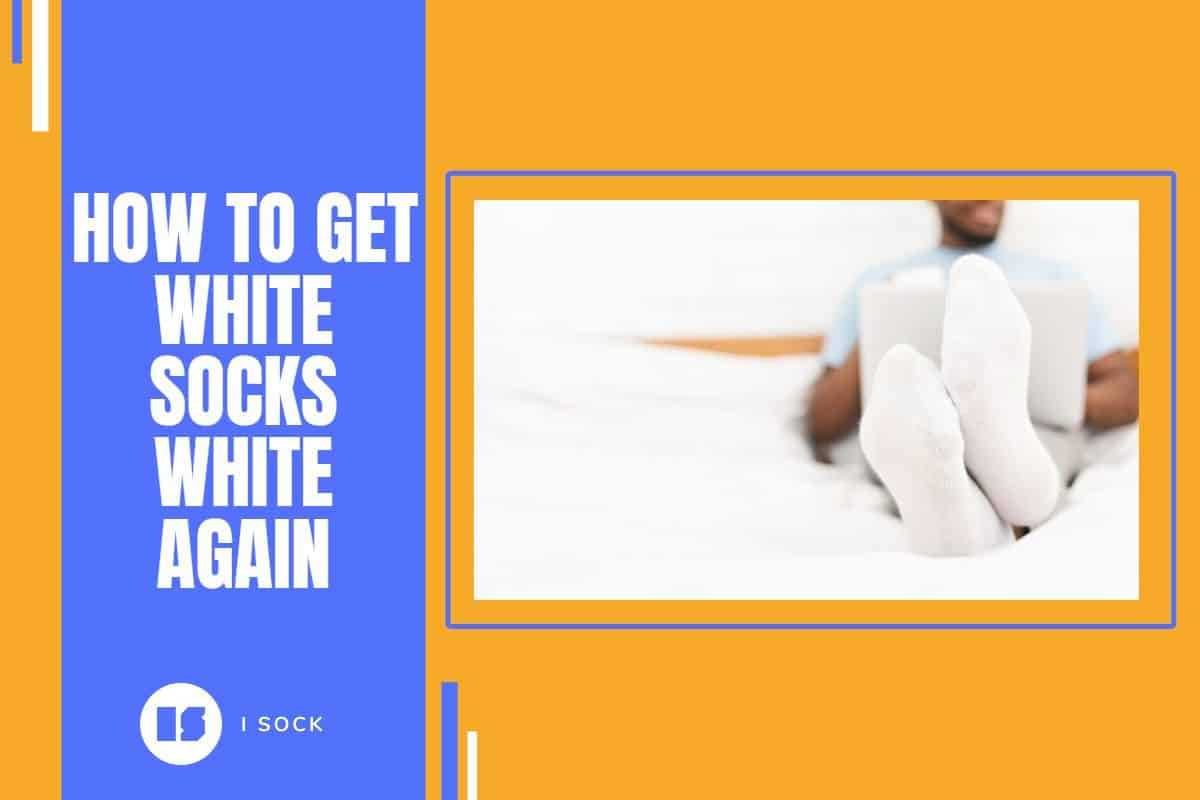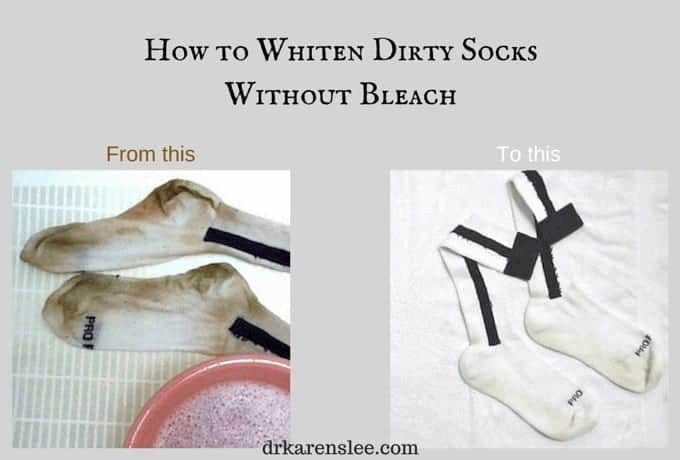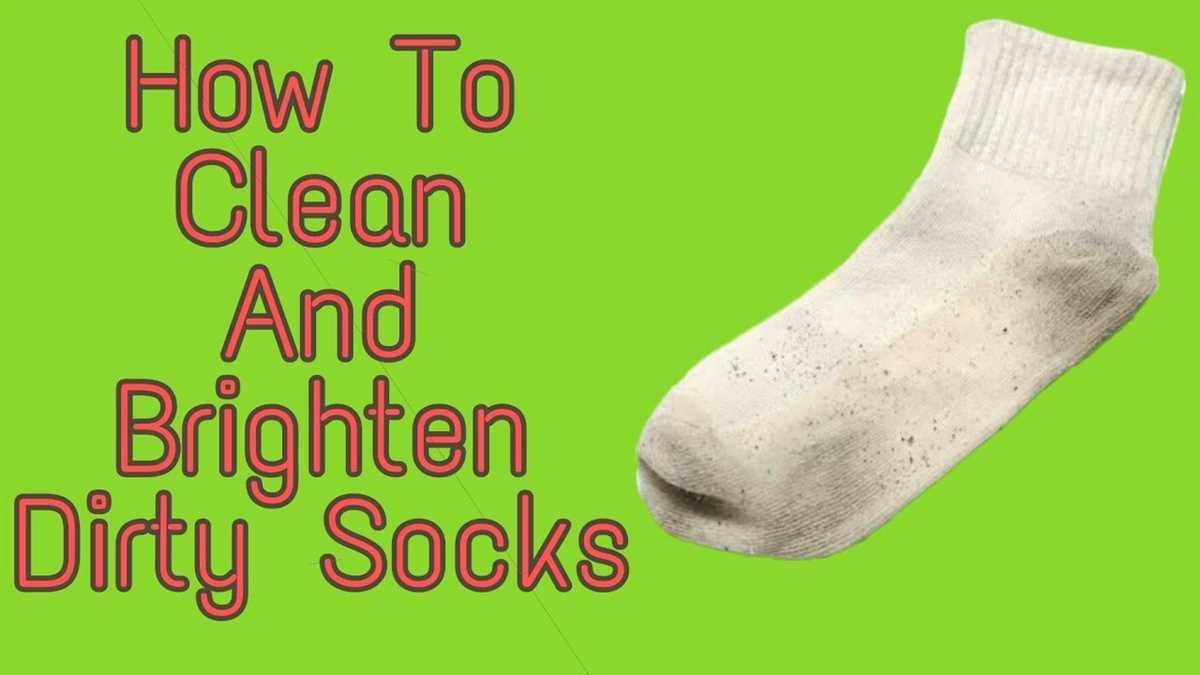
Having bright white socks can make a big difference in your overall appearance. However, over time, your socks can become dingy, stained, and lose their whiteness. If you’re tired of throwing away your once-white socks and want to restore their bright white color, we have some expert tips and techniques to help you.
1. Soak in a Whitening Solution
If your socks have stubborn stains or are heavily discolored, soaking them in a whitening solution can help to remove the stains and restore their whiteness. Mix a solution of equal parts water and bleach or an oxygen-based whitening agent. Soak the socks for at least 30 minutes, then wash them as usual. Remember to read and follow the instructions on the product label carefully.
2. Use Baking Soda and Vinegar
If you prefer a natural and gentler approach, try using baking soda and vinegar. First, mix a paste of baking soda and water and apply it to the stains. Let it sit for 15-30 minutes, then rinse with cold water. Then, create a mixture of equal parts water and vinegar and soak the socks for 1-2 hours. Finally, wash the socks as usual.
Expert tip: You can also add a cup of vinegar to your regular laundry cycle to help remove stains and whiten your socks.
3. Try Lemon Juice and Sunlight
Lemon juice is a natural bleaching agent that can help to whiten your socks. Squeeze fresh lemon juice onto the stains and rub it in gently. Let the socks dry in direct sunlight for a few hours. The combination of lemon juice and sunlight will work together to naturally bleach and whiten your socks.
By following these expert tips and techniques, you can easily restore the whiteness of your socks and extend their lifespan. Remember to always read and follow the care instructions on your socks’ label, and be patient as it may take a few attempts to achieve the desired results. Happy whitening!
Why Do Socks Lose Their Whiteness?
Socks are an essential part of our daily wardrobe, providing comfort and protection for our feet. However, over time, socks may lose their whiteness and start to look dull and discoloured. There are several reasons why this happens:
- Wear and tear: Socks go through a lot of wear and tear, especially if they are worn frequently. The constant friction against shoes and sweat can contribute to the staining and discoloration of socks.
- Sweat: Our feet naturally sweat, and the sweat can contain compounds that can cause socks to become discoloured. Sweat can also create a humid environment inside the shoes, promoting the growth of bacteria, which can further contribute to the staining of socks.
- Dirt and grime: As we walk or engage in various activities, our socks can come into contact with dirt, dust, and other substances. These particles can accumulate on the socks and cause them to lose their whiteness.
- Washing and laundry practices: Improper washing and laundry practices can also contribute to the loss of whiteness in socks. Using harsh detergents, not separating white socks from colored ones, and not washing socks at appropriate temperatures can all affect the brightness of the socks.
- Age and material: Socks, like any other fabric, can fade and lose their whiteness over time. The material of the socks can also affect their resistance to staining and discoloration.
Knowing the reasons behind the loss of whiteness in socks can help us take preventive measures and adopt effective cleaning techniques to restore their brightness and maintain their appearance.
The Main Causes of Discoloration
There are several factors that can cause socks to become discolored over time. Understanding the main causes will help you take appropriate measures to prevent or treat the discoloration.
Prolonged Wear and Sweat
Socks that are worn for long periods of time, especially in hot and humid conditions, can become discolored due to sweat. Sweat contains natural oils, salts, and other substances that can cause stains on the fabric.
Use of Harsh Detergents
Some detergents contain harsh chemicals that can cause colors to fade or change. Using these detergents to wash your socks can lead to discoloration over time. It is recommended to use mild detergents specifically formulated for delicate fabrics.
Exposure to Sunlight

Excessive exposure to sunlight can cause socks to fade and lose their original color. Ultraviolet (UV) rays from the sun can break down the dyes and fibers in the fabric, resulting in discoloration. It is best to dry socks in a shaded area to minimize sun exposure.
Incorrect Washing Techniques
Improper washing techniques, such as using excessively hot water or washing socks with dark-colored clothing, can contribute to discoloration. Mixing different colored socks together can cause dyes to bleed onto each other, resulting in stains and discoloration.
Residue from Other Substances
If your socks come into contact with substances like bleach, cleaning agents, or even certain foods or beverages, they can absorb the residue and become discolored. It is important to keep socks away from such substances to avoid discoloration.
Worn-out Fabric
Over time, the fabric of socks can start to wear out and lose its color. This is a natural process that occurs with repeated use and washing. Once the fabric starts to thin out, it can become more susceptible to discoloration.
By being aware of these main causes of discoloration, you can take preventive measures and adopt proper cleaning techniques to maintain the whiteness of your socks for as long as possible.
The Importance of Restoring Whiteness
It is not uncommon for white socks to lose their original brightness and become dull and discolored over time. This can be due to a variety of factors such as wearing them frequently, stains, or improper washing techniques. However, restoring the whiteness of socks is important for several reasons.
1. Aesthetics
White socks are a classic choice that can help complete a clean and put-together look. When socks are discolored, it can detract from an overall polished appearance. By restoring their whiteness, you can enhance the visual appeal of your socks and outfit.
2. Hygiene

The color of your socks can affect how clean they appear to be. Discolored socks may give the impression of being dirty, even if they are freshly washed. By restoring their whiteness, you can ensure that your socks look and feel clean, promoting good hygiene practices.
3. Longevity

White socks that are properly cared for and regularly restored can have a longer lifespan compared to those that are neglected. By maintaining their whiteness, you can prevent the accumulation of dirt and stains, extending the usability of your socks.
4. Versatility
White socks are versatile and can be worn with a wide range of outfits, from casual to formal. When your socks maintain their original whiteness, you can confidently pair them with any ensemble, knowing that they will complement your look perfectly.
In conclusion, restoring the whiteness of socks is important for both aesthetic and practical reasons. By maintaining their brightness, you can elevate your overall appearance, promote good hygiene, prolong their lifespan, and enhance their versatility. So, don’t let discolored socks bring down your style – invest time and effort into restoring their whiteness for a clean and polished look.
Expert Tips for Restoring Whiteness
1. Sort your socks
Before attempting to restore the whiteness of your socks, it’s important to sort them according to their color and fabric. This will help you choose the right method for each type of sock.
2. Pre-treat the stains
If your socks have stubborn stains, it’s a good idea to pre-treat them before washing. Apply a small amount of stain remover or laundry detergent directly to the stained area and let it sit for a few minutes before washing.
3. Use hot water
Hot water is effective in removing dirt and stains from white socks. Make sure to check the care label on your socks, as some fabrics may require cold or lukewarm water. Use the highest water temperature recommended for your socks to achieve the best results.
4. Choose a bleach alternative
Instead of using chlorine bleach, which can damage the fibers of your socks, opt for a bleach alternative. Oxygen or hydrogen peroxide-based whiteners are gentle yet effective in restoring whiteness. Follow the instructions on the product for the correct dosage.
5. Soak your socks
For heavily soiled or stained socks, consider soaking them in a mixture of warm water and a laundry booster. This will help loosen the dirt and stains before washing. Follow the product instructions for the recommended soaking time.
6. Scrub gently
If your socks have stains that are difficult to remove, you can gently scrub the affected areas with a soft-bristled brush or toothbrush. Be careful not to scrub too hard or you may damage the fabric.
7. Dry your socks properly
Avoid drying your white socks in direct sunlight, as this can cause them to yellow. Instead, hang them to dry in a shaded area or use a dryer on a low heat or delicate setting.
8. Repeat if necessary
If your socks are still not as white as you’d like them to be, you can repeat the washing or soaking process. It may take a few tries to completely restore the whiteness, especially for heavily stained socks.
9. Prevent future stains
To keep your white socks looking their best, consider taking preventive measures. Avoid walking on dirty surfaces, treat stains as soon as they happen, and wash your socks separately from colored clothing to prevent color transfer.
10. Use a laundry whitener
If all else fails, you can try using a laundry whitener specifically designed to restore whiteness. These products are formulated to brighten white fabrics and can be used as a final step in the washing process.
Natural Methods for Brightening Socks
If your socks have become dull or discolored over time, you don’t need to resort to harsh chemicals to brighten them up. There are several natural methods you can use to restore the whiteness of your socks. Here are some expert tips and techniques:
1. Lemon Juice
Lemon juice is a natural bleaching agent that can help whiten your socks. Simply mix equal parts lemon juice and water in a bowl or basin. Soak your socks in the mixture for about 30 minutes, then wash them as usual. The acidic properties of the lemon juice will help remove stains and brighten the fabric.
2. Baking Soda
Baking soda is another effective natural ingredient that can help whiten socks. Create a paste by mixing baking soda with water until it forms a thick consistency. Apply the paste directly onto the stained areas of your socks and let it sit for a few hours or overnight. Then, wash your socks as you normally would. The baking soda will help lift stains and restore whiteness to the fabric.
3. Vinegar
Vinegar is a versatile ingredient that can be used for various cleaning purposes, including brightening socks. Fill a basin with equal parts white vinegar and water. Soak your socks in the mixture for a few hours, or overnight for heavily stained socks. Then, wash them as usual. Vinegar helps break down stains and eliminate odors, leaving your socks looking fresh and bright.
4. Sunlight
One of the easiest and most natural ways to brighten socks is by letting them soak up some sunlight. Hang your socks outside on a clothesline or lay them flat on a clean surface exposed to direct sunlight. The UV rays from the sun will help bleach out stubborn stains and naturally brighten the fabric. Leave them out for a few hours, checking periodically until they reach the desired level of brightness.
5. Hydrogen Peroxide
Hydrogen peroxide is a gentle yet effective natural bleaching agent that can be used to whiten socks. Mix equal parts hydrogen peroxide and water in a bowl or basin. Soak your socks in the mixture for about 15-30 minutes, then wash as usual. The hydrogen peroxide will help remove stains and restore the whiteness of your socks.
Remember to always check the care instructions on your socks before using any of these methods, as some fabrics may not be suitable for certain treatments. Additionally, it’s a good idea to spot test any cleaning solution on a small, inconspicuous area of your socks before treating them fully.
Effective Techniques for Stubborn Stains
While some stains may come out easily with regular washing, others require a more targeted approach. Here are some effective techniques to tackle stubborn stains on your socks:
- Pretreatment: Before washing your socks, it’s important to pretreat the stains. Apply a small amount of stain remover or laundry detergent directly onto the stained areas. Gently rub the fabric together to work in the pretreatment solution.
- Soak in a solution: For tough stains, create a solution by mixing equal parts of water and oxygen-based bleach. Place the stained socks in the solution and allow them to soak for at least 30 minutes. This will help to lift the stains before washing.
- Scrubbing: After soaking, scrub the stained areas with a soft brush or an old toothbrush. Apply some additional stain remover or laundry detergent and scrub in a circular motion to help loosen the stain particles.
- Baking soda paste: If the stains are still visible, make a paste by mixing baking soda with water. Apply the paste onto the stained areas and let it sit for about 15 minutes. Then, scrub the paste with a brush and rinse thoroughly.
- Lemon juice: Lemon juice can help to remove stubborn stains and brighten the socks. Squeeze fresh lemon juice onto the stained areas and let it sit for about 15 minutes. Rinse the socks and wash as usual.
- Vinegar soak: Create a solution by mixing equal parts of white vinegar and water. Soak the stained socks in the solution for 1-2 hours. Vinegar can help to break down the stains and eliminate any odors.
- Use bleach as a last resort: If all else fails and the stains are not coming out, you may consider using chlorine bleach. Be careful when using bleach as it can affect the color and integrity of the fabric. Follow the instructions on the bleach packaging and use it sparingly.
Remember to always read and follow the care instructions on your socks before attempting any stain removal techniques. Additionally, spot testing a small inconspicuous area of the socks before applying any cleaners or bleaches is recommended to avoid any potential damage.
FAQ
What are some expert tips to restore the whiteness of socks?
There are several expert tips to restore the whiteness of socks. One tip is to soak the socks in a mixture of warm water and bleach, then wash them as usual. Another tip is to use a whitening detergent or stain remover specifically designed for white socks. Additionally, soaking the socks in vinegar or lemon juice can help remove stains and restore their whiteness.
How can I use bleach to restore the whiteness of socks?
To use bleach for restoring the whiteness of socks, you should first dilute it in warm water according to the instructions on the bleach bottle. Then, soak the socks in the mixture for about 30 minutes to an hour. After soaking, wash the socks as usual with laundry detergent. Be sure to handle bleach carefully and follow the safety precautions mentioned on the bottle.
Are there any natural ways to restore the whiteness of socks?
Yes, there are natural ways to restore the whiteness of socks. One natural method is to soak the socks in a mixture of vinegar and warm water for a few hours before washing. Another natural method is to soak the socks in lemon juice, as the citric acid in lemon acts as a natural bleaching agent. Alternatively, you can try sun bleaching the socks by hanging them outside on a sunny day.
Is it possible to restore the whiteness of socks if they have stubborn stains?
Yes, it is possible to restore the whiteness of socks even if they have stubborn stains. If the stains are tough to remove, you can try pre-treating them with a stain remover or applying a paste made of hydrogen peroxide and baking soda. Let the stain remover or paste sit on the stains for a while before washing. For heavily stained socks, it may take multiple attempts to completely restore their whiteness.












